UDAIPUR
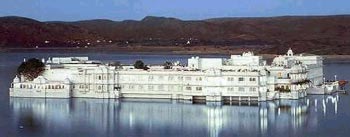 Possibly no city in Rajasthan is quite as romantic as Udaipur, even
though the state is replete with fantastic hilltop fortresses, exotic
fairytale palaces and gripping legends of medieval chivalry and heroism.
The French Impressionist painters, let along the Brothers Grimm, would
have loved this palace and it’s not without justification that Udaipur
has been called the ‘Venice of the East’. Jaisalmer is certainly the
‘Beau Geste’ of the desert and Udaipur is the ‘Versailles’.
Possibly no city in Rajasthan is quite as romantic as Udaipur, even
though the state is replete with fantastic hilltop fortresses, exotic
fairytale palaces and gripping legends of medieval chivalry and heroism.
The French Impressionist painters, let along the Brothers Grimm, would
have loved this palace and it’s not without justification that Udaipur
has been called the ‘Venice of the East’. Jaisalmer is certainly the
‘Beau Geste’ of the desert and Udaipur is the ‘Versailles’.
Founded in 1568 by Maharana Udai Singh
following the final sacking of Chittorgarh by the Mughal emperor, Akbar,
Udaipur rivals any of the world-famous creations of the Mughals with its
Rajput love of the whimsical and its superbly crafted elegance. The Lake
Palace is certainly the best late example of this unique cultural
explosion, but Udaipur is full of palaces, temples and havelis ranging
from the modest to the extravagant. It’s also proud of its heritage as
a centre for the performing arts, painting and crafts. And, since water
is relatively plentiful in this part of the state (in between the
periodic droughts), there are plenty of parks and gardens, many of which
line the lakeshores.
Until recent times, the higher uninhabited parts of the
city were covered in forests but, as elsewhere in India, most of these
have is, however, a movement afoot to reverse this process. The city was
once surrounded by a wall and, although the gates and much of the wall
over the higher crags remain, a great deal of it has befallen such a
historic place but the essence remains.
In common with all Indian
cities, Udaipur’s urban and industrial sprawl goes beyond the city’s
original boundaries and pollution of various kinds can be discouraging.
This will be your first impression of Udaipur if you arrive at the
railway or bus stations. Ignore it and head for the old city where a
different world is waiting for you.
Orientation
The old city, bound by the remains of a city wall, is on the east
side of Lake Pichola. The railway and bus stations are both just outside
the city wall to the south-east.
Lake Pichola
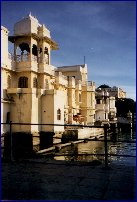 The beautiful Lake Pichola was enlarged by Maharana Udai Singh after he
founded the city. He built a masonry dam, known as the Badi Pol, and the
lake is now four km in length and three km wide. Nevertheless, it
remains fairly shallow and can actually dry up in severe droughts. At
these times, you can walk to the island palaces from the shore.
Fortunately, this doesn’t happen often. The City Palace extends a
considerable distance along the east bank of the lake. South of the
palace, a pleasant gardens runs down to the lake. North of the palace,
you can wander along the lake, where there are some interesting bathing
and dhobi (laundry) ghats.
The beautiful Lake Pichola was enlarged by Maharana Udai Singh after he
founded the city. He built a masonry dam, known as the Badi Pol, and the
lake is now four km in length and three km wide. Nevertheless, it
remains fairly shallow and can actually dry up in severe droughts. At
these times, you can walk to the island palaces from the shore.
Fortunately, this doesn’t happen often. The City Palace extends a
considerable distance along the east bank of the lake. South of the
palace, a pleasant gardens runs down to the lake. North of the palace,
you can wander along the lake, where there are some interesting bathing
and dhobi (laundry) ghats.
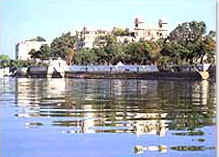 Out in the lake are two
islands- Jagniwas and Jagmandir. Boat rides, which leave regularly from
the City Palace jetty (known as Bansi Ghat), are pleasant but expansive.
Out in the lake are two
islands- Jagniwas and Jagmandir. Boat rides, which leave regularly from
the City Palace jetty (known as Bansi Ghat), are pleasant but expansive.
Jagniwas Island (Lake Palace Hotel)
Jagniwas, the lake Palace island, is
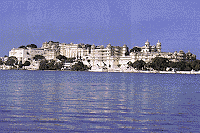 about 1.5 hectares in size. The
palace was built by Maharana Jagat Singh II in 1754 and covers the whole
island. Today, it has been converted into the ultimate in luxury hotels,
with courtyards, fountains, gardens and a swimming pool. It’s a
magical place but casual visitors are discouraged. It’s magical place
but casual visitors are discouraged. It used to be possible to visit the
palace for afternoon tea but now non-guests can only come over for lunch
or dinner – and then only if the hotel is not full, which it often is.
Hotel launches cross to the island form the City Palace jetty.
about 1.5 hectares in size. The
palace was built by Maharana Jagat Singh II in 1754 and covers the whole
island. Today, it has been converted into the ultimate in luxury hotels,
with courtyards, fountains, gardens and a swimming pool. It’s a
magical place but casual visitors are discouraged. It’s magical place
but casual visitors are discouraged. It used to be possible to visit the
palace for afternoon tea but now non-guests can only come over for lunch
or dinner – and then only if the hotel is not full, which it often is.
Hotel launches cross to the island form the City Palace jetty.
Jagmandir Island
 The other island palace, Jagmandir, was commented by Maharana Karan
Singh, but takes its name from Maharana Jagat Singh (1628-52) who made a
number of additions to it. It is said that the Mughal emperor, Shah
Jahan, derived some of his ideas for the Taj Mahal from this palace
after staying here in 1623-24 while leading a revolt against his father,
Jehangir. The view across the lake from the southern end, with the city
and its great palace rising up behind the island palaces, is a scene of
rare beauty.
The other island palace, Jagmandir, was commented by Maharana Karan
Singh, but takes its name from Maharana Jagat Singh (1628-52) who made a
number of additions to it. It is said that the Mughal emperor, Shah
Jahan, derived some of his ideas for the Taj Mahal from this palace
after staying here in 1623-24 while leading a revolt against his father,
Jehangir. The view across the lake from the southern end, with the city
and its great palace rising up behind the island palaces, is a scene of
rare beauty.
City Palace & Museums
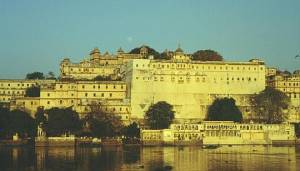 The huge City Palace, towering over the lake, is the largest palace
complex in Rajdhani. Actually a conglomeration of buildings added by
various maharanas, the palace managers to retain a surprising uniformity
of design. Building was started by Maharana Udai Singh, the city’s
founder. The palace is surmounted by balconies, towers and cupolas and
there are fine views over the lake and the city form the upper terraces. The palace is entered from
the northern end
through the Bari Pol of 1600 and the Tripolia Gate of 1725, with its
eight carved marble arches. It was once a custom for maharanas to be
weighed under the gate and their weight in gold or silver distributed to
the populace.
The huge City Palace, towering over the lake, is the largest palace
complex in Rajdhani. Actually a conglomeration of buildings added by
various maharanas, the palace managers to retain a surprising uniformity
of design. Building was started by Maharana Udai Singh, the city’s
founder. The palace is surmounted by balconies, towers and cupolas and
there are fine views over the lake and the city form the upper terraces. The palace is entered from
the northern end
through the Bari Pol of 1600 and the Tripolia Gate of 1725, with its
eight carved marble arches. It was once a custom for maharanas to be
weighed under the gate and their weight in gold or silver distributed to
the populace.
The main part of the palace is now preserved as a
museum with a large and varied, although somewhat run-down, collection.
The museum includes the Mor Chowk with its beautiful mosaics of
peacocks, the favourite Rajasthani bird. The Manak (or Ruby) Mahal has
glass and porcelain figures while Krishna Vilas has a remarkable
collection of miniatures. In the Bari Mahal, there is a fine central
garden. More paintings can be seen in the Zanana Mahal. The Moti Mahal
has beautiful mirrorwork and the Chini Mahal is covered in ornamental
tiles.
Enter the City Palace Museum
through the Ganesh Deori which leads to the Rai Angam, or Royal
Courtyard. The museum is open from 9:30 am to 4:30 pm. There’s also a government
museum within the palace complex. Exhibits include a stuffed
kangaroo, a scarcely recognisable ostrich and Siamese-twin deer.
The other part of the palace is up against the lake
shore and, like the Lake Palace, it has been converted into a luxury
hotel- two, in fact, known as the Shiv Niwas Palace and the Fateh
Prakash hotels.
Jagdish Temple
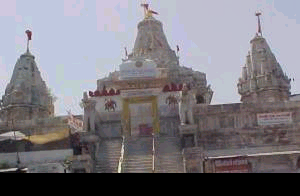 Located only 150 metres north of the entrance to the City Palace, this
fine Indo- Aryan temple was built by Maharana Jagat Singh in 1651 and
enshrines a black stone image to Vishnu as Jagannath, Lord of the
Universe. A brass image of the Garuda is in a shrine in front of the
temple and the steps up to the temple are flanked by elephants.
Located only 150 metres north of the entrance to the City Palace, this
fine Indo- Aryan temple was built by Maharana Jagat Singh in 1651 and
enshrines a black stone image to Vishnu as Jagannath, Lord of the
Universe. A brass image of the Garuda is in a shrine in front of the
temple and the steps up to the temple are flanked by elephants.
Bagore Ki Haveli
This 18th –century is on the lake shore, below the
Jagdish Temple. It was built by a nobleman, and was once used as a royal
guest house. It was one of the finest examples of its type, and now
houses the Western Zone Cultural Centre. The labyrinthine haveli houses
a graphics studio, art gallery (which occasionally has exhibitions by
local artists), and some fine coloured glass and inlay work. Its open
daily from 9:30 am to 6 pm.
Fateh Sagar
![]() North of Lake Pichola, this lake is over-looked by a number of hills and
parks. It was originally built in 1678 by Maharana Jai Singh but, after
heavy rains destroyed the dam, it was reconstructed by Maharana Fateh
Singh. A pleasant lakeside drive winds along the east bank of the lake.
In the middle of the lake is Nehru Park, a popular garden island with a
boat-shaped café. You can get there by boat from near the bottom of
Moti Magri Hill.
North of Lake Pichola, this lake is over-looked by a number of hills and
parks. It was originally built in 1678 by Maharana Jai Singh but, after
heavy rains destroyed the dam, it was reconstructed by Maharana Fateh
Singh. A pleasant lakeside drive winds along the east bank of the lake.
In the middle of the lake is Nehru Park, a popular garden island with a
boat-shaped café. You can get there by boat from near the bottom of
Moti Magri Hill.
Pratap Samak
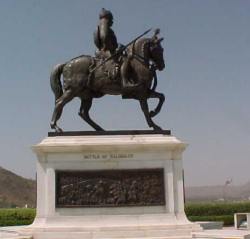 Atop the Moti Magri, or Pearl Hill, overlooking Fateh Sagar, is a statue
of the Rajput hero Maharana Pratap, who frequently defied Maharana
Pratap, who frequently defied the Mughals. The path to the top traverses
elegant gardens, including a Japanese rock garden. The park is
open from 9 am to 6 pm.
Atop the Moti Magri, or Pearl Hill, overlooking Fateh Sagar, is a statue
of the Rajput hero Maharana Pratap, who frequently defied Maharana
Pratap, who frequently defied the Mughals. The path to the top traverses
elegant gardens, including a Japanese rock garden. The park is
open from 9 am to 6 pm.
Bhartiya Lok Kala Museum
The interesting collection exhibited by this small museum and foundation
for the preservation of folks arts include dresses, dolls, masks,
musical instruments, paintings and –the high point daily from 9 am to
6 pm. Regular puppet shows are held daily from 6 to 7 pm.
Saheliyon Ki Bari
The
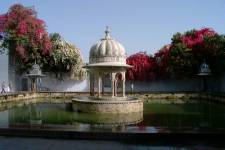 Saheliyon ki Bari, or Garden of the Maids of Honour, is in the north
of the city. This small ornamental garden, with its fountains, kiosks,
marble elephants and delightful lotus pool, is open from 9 am to 6 pm.
Saheliyon ki Bari, or Garden of the Maids of Honour, is in the north
of the city. This small ornamental garden, with its fountains, kiosks,
marble elephants and delightful lotus pool, is open from 9 am to 6 pm.
Shilpgram
Shilpgram, a crafts village three km west of Fateh Sagar, was
inaugurated by Rajiv Gandhi in 1989. It’s an interesting place with
traditional houses from four states-Rajasthan, Gujarat, Goa and
Maharashtra- and there are daily demonstrations by musicians, dancers,
or artisans from the various states. Although it’s much more animated
during festival times, there’s usually something happening.
The site covers 80 hectares
but most buildings are in a fairly compact area. It’s open daily from
9:30 am to 4:30 pm
Ahar Museum
Three km east of Udaipur are the remains of an ancient city. Here,
you’ll find a small museum and the cenotaphs of the Maharanas of Mewar.
Other Attractions
Patel or Sukhadia Circle is north of the city. The huge fountain
in the center is illuminated at night. Sajjan Niwas Gardens have
pleasant lawns, a zoo and a children’s train. Beside it is the Rose
Garden, or Gulab Bagh. Don’t confuse the Nehru Park
opposite Bapu Bazaar with the island park of the same name in Fateh
Sagar. The city park has some strange topiary work, a giant cement
teapot and children’s slides incorporating an elephant and a camel.
On the distant mountain range, the
gleaming white edifice visible from the city is the former maharaja’s Monsoon
Palace. Now deserted, the views from the top are incomparable. The
round trip takes about three hours.
Things to Buy
Udaipur has countless small shops and many interesting local crafts,
particularly miniature paintings in the Rajput- Mughal style. There’s
good cluster of these shops on Lake Palace Rd, next to the Rang Niwas
Palace Hotel, and others around the Jagdish Temple.
AROUND UDAIPUR
Eklingi & Nagada
 The interesting little village of Eklingi, with a number of ancient temples,
is only 22 km and a short bus ride north of Udaipur. The Shiva temple in
the village itself was originally built in 734, although its present
form dates from the rule of Maharana Raimal between 1473 and 1509. The
walled complex includes an elaborately pillared hall under a large
pyramidal roof and features a four- faced Siva image of black marble.
The temple is open at rather odd hours-5 to 7 am, 10 am to 1 pm and 5 to
7 pm.
The interesting little village of Eklingi, with a number of ancient temples,
is only 22 km and a short bus ride north of Udaipur. The Shiva temple in
the village itself was originally built in 734, although its present
form dates from the rule of Maharana Raimal between 1473 and 1509. The
walled complex includes an elaborately pillared hall under a large
pyramidal roof and features a four- faced Siva image of black marble.
The temple is open at rather odd hours-5 to 7 am, 10 am to 1 pm and 5 to
7 pm.
 At Nagada, about a km off the road and a km
before Eklingi, are three old temples. The Jain temple of Adbudji
is essentially ruined, but its architecture is interesting and it’s
very old. The nearby Sas Bahu, or Mother and Daughter-in-Law,
group has very fine and intricate architecture and carvings, including
some erotic figures. You can reach these temples most conveniently by
hiring a bicycle in Eklingi itself.
At Nagada, about a km off the road and a km
before Eklingi, are three old temples. The Jain temple of Adbudji
is essentially ruined, but its architecture is interesting and it’s
very old. The nearby Sas Bahu, or Mother and Daughter-in-Law,
group has very fine and intricate architecture and carvings, including
some erotic figures. You can reach these temples most conveniently by
hiring a bicycle in Eklingi itself.
Haldighati
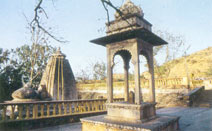
This site, 40 km form Udaipur, is where Maharana Pratap valiantly defied
the superior Mughal forces of Akbar in 1576. The site is a battlefield
and the only thing to see is the chhatri to the warrior’s horse,
Chetak, a few km away.
Nathdwara
![]()
The important 18th –century Vishnu temple of Sri Nathji
stands here, 48 km from Udaipur, and it’s an important shrine for
Vaishnavite devotees. The black stone Vishnu image was brought here from
Mathura in 1699 to protect if from Aurangzeb’s destructive impulses.
According to legend, when an attempt was later made to move the image,
the gateway vehicle, a wagon, sank into the ground up to the axles,
indicating that the image preferred to stay where it was!
Kankroli & Rajsamand Lake
At Kankroli, Dwarkadhish (an incarnation of Vishnu) has a temple
similar to the temple at
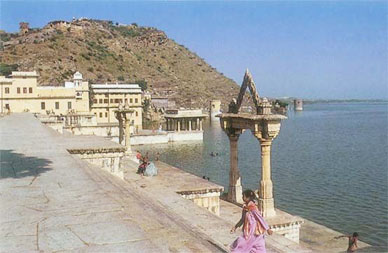 Nathdwara and opening hours here are similarly
erratic.
Nathdwara and opening hours here are similarly
erratic.
Nearby is a lake created by the dam
constructed in 1660 by Maharana Raj Singh. There are many ornamental
arches and chhatris along the huge bund (embankment).
Kumbhalgarh Fort
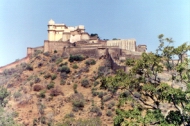 Eighty four km from Udaipur, this is the most important fort in
the Mewar region after Chittorgarh. It’s an isolated and fascinating
place, built by Maharana Kumbha in the 15th century and, due
to its inaccessibility on top of the Aravalli range of 1100 metres, it
was taken only once in its history. Even then, it took the combined
armies of the Mughal emperor, Akbar, and those of Amber and Marwar to
breach its defences. It was here that the rulers of Mewar retreated in
times of danger.
Eighty four km from Udaipur, this is the most important fort in
the Mewar region after Chittorgarh. It’s an isolated and fascinating
place, built by Maharana Kumbha in the 15th century and, due
to its inaccessibility on top of the Aravalli range of 1100 metres, it
was taken only once in its history. Even then, it took the combined
armies of the Mughal emperor, Akbar, and those of Amber and Marwar to
breach its defences. It was here that the rulers of Mewar retreated in
times of danger.
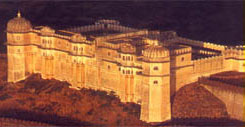 The walls of the fortress stretch some 12 km and
enclose many temples, palaces, gardens and water-storage facilities. The
fort was renovated in the last century.
The walls of the fortress stretch some 12 km and
enclose many temples, palaces, gardens and water-storage facilities. The
fort was renovated in the last century.
There’s also a game reserve here, known for
its wolves. The scarcity of waterholes between March and June makes this
the best time to see animals. Other wildlife includes antelope (a rare
four-horned species), leopard and bear, and it’s good area for
walking.
There’s a PWD Rest House, or the upmarket Aodhi
Hotel where double rooms.
Ranakpur
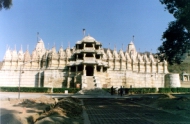 One of the biggest and most important Jain temples in India, the
extremely beautiful Ranakpur complex is well worth seeing. Sixty km from
Udaipur, it lies in a remote and peaceful valley of the Aravalli range.
One of the biggest and most important Jain temples in India, the
extremely beautiful Ranakpur complex is well worth seeing. Sixty km from
Udaipur, it lies in a remote and peaceful valley of the Aravalli range.
 The main temple is the Chaumukha Temple, or
Four-Faced Temple, dedicated to Adinath. Built in 1439, this huge,
beautifully crafted and well-kept marble temple has 29 halls supported
by 1444 pillars, no two alike. Within the complex are two other Jain
temples to Neminath and Parasnath and, a little distance away, a Sun
Temple. One km from the main complex is the Amba Mata Temple.
The main temple is the Chaumukha Temple, or
Four-Faced Temple, dedicated to Adinath. Built in 1439, this huge,
beautifully crafted and well-kept marble temple has 29 halls supported
by 1444 pillars, no two alike. Within the complex are two other Jain
temples to Neminath and Parasnath and, a little distance away, a Sun
Temple. One km from the main complex is the Amba Mata Temple.
The temple is open to non-Jains from noon to 5 pm. Shoes
and all leather articles must be left at the entrance.
Ghanerao
 The attractive town of Ghanerao can make a good base for explorations of
the various attractions around Udaipur. The Ghanerao Royal Castle’s
helpful owners can arrange a trek from Ghanerao to Kumbhalgarh with an
overnight stay at their hunting lodge, Bagha ka Bagh, en route. They
offer very expensive horse safaris or reasonably priced excursions by
jeep.
The attractive town of Ghanerao can make a good base for explorations of
the various attractions around Udaipur. The Ghanerao Royal Castle’s
helpful owners can arrange a trek from Ghanerao to Kumbhalgarh with an
overnight stay at their hunting lodge, Bagha ka Bagh, en route. They
offer very expensive horse safaris or reasonably priced excursions by
jeep.
Situated about a km out of town, the Ghanerao
Royal Castle is a red sandstone castle with 20 well-kept rooms.
Jaisamand Lake
Located 48 km south-west of Udaipur, this stunningly sited artificial
lake, created by damming the Gomti River, was built by Maharana Jai
Singh in the17th century. There are beautiful marble chhatris around the
embankment, each with an elephant in front. The summer palaces of the
Udaipur queens are also here and a wildlife sanctuary is nearby.





